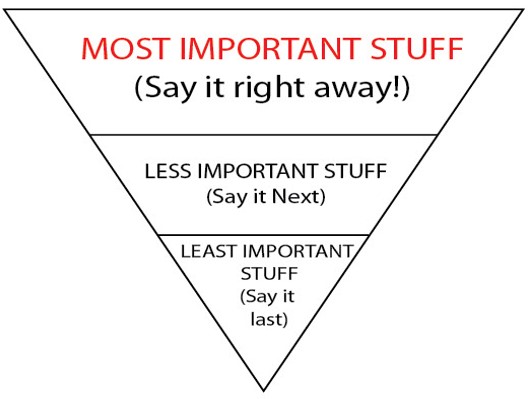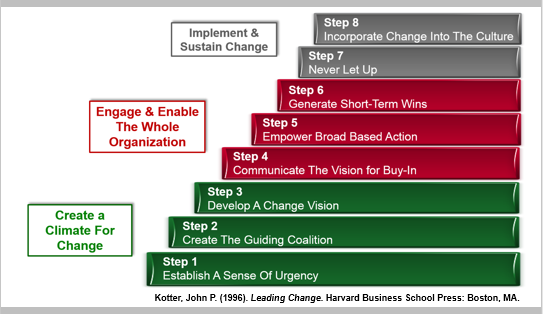In my prior article focused on five major gates or steps for innovation in any organization, I emphasized three essential leadership skills for leading innovation within large organizations:
- Establishing urgency: Communicating a compelling vision and context with power,
- Boundary spanning and coalition building, and
- Effective use of metrics and data to build a case to scale up (institutionalize) the innovation.
This article focuses on why establishing urgency is vital to any change initiative, and the importance of boundary spanning and coalition to build necessary support required for scaling up, and institutionalizing any innovative project, product or new process within your organization.
Regarding the third key skill for leading innovation, effective use of metrics and data, see my articles about strategic planning tracking. I share useful tips for tracking and sharing goal and innovation progress.
John Kotter completed research and wrote a prolific book that described the top reasons why change initiatives fail[1]. The No. 1 reason is this: Failure to establish a sense of urgency. Applied to the innovation process, this equates to the absolute need to create urgency for the innovative, big opportunity!
Therefore, one of the most important leadership skill for innovation leaders is creating an appropriate sense of urgency within the organization – urgency that creates rationale and widespread buy-in for change and innovation.
The best way to establishing urgency is to speak in soundbites. That is, you must clearly and succinctly communicate the importance of your big opportunity, in the same way celebrities, spokespersons, and famous public speakers shape and craft their key messages.
You must convey a compelling vision and context with power. How? By creating a communicating your Big Opportunity Statement. Most are:
- Short and clear
- Rational
- Compelling
- Positive
- Aligned with the strategic plan and goals of your organization
- Authentic
To speak in soundbites, you must use what journalists call pyramid-style packaging. That is, you must create a bold statement with the most important information first, followed by supporting data, analogies, examples, rhetorical questions and appropriate humor. That way, your most important bold statement becomes the headliner and is remembered.
As a great example, the City of Phoenix and its Reimagine Phoenix innovative program was incubated, and has been scaled up, to achieve a grand vision: Eliminate the city’s landfill waste by 2050. The most dramatic and important point is that Phoenix wants to eliminate one million tons of trash sent to the landfill annually by recycling and repurposing that trash.
Other important points (after that sizzling soundbite) include the goal of reducing waste by 40 percent by the year 2020, and Phoenix’ goal of creating a circular economy of manufacturing products, consumption/use of those products, and recycling/repurposing the products as these become trash. In doing so, new types of jobs will be supported, creating a more sustainable and economically healthy city.
Of course, there’s much more to this interesting story, but creating the urgent soundbite of reducing one million tons of trash buried in a Phoenix landfill by 2050 is compelling and provides the first step for engaging employees, community leaders and residents.

If you are an innovation leader, powerful soundbites can help you own your messages and accelerate your big opportunity, building your coalition of supporters. Soundbites help people remember what you said, and why you said it. But it takes time and practice to fully shape your most important, urgent and compelling key points.
The second most important skill for effective innovation leaders is the ability to be a “boundary spanner” and build momentum for your change. Kotter’s most updated research emphasizes the importance of gaining buy-in from at least half of the organization as well as creating an army of active supporters throughout the organization.
The five types of boundary spanning[2]include vertical (across levels and hierarchy), horizontal (across functional divisions within an organization), stakeholder (external constituents), demographic (across diverse groups including age gender, ethnicity, nationality) and geographic (locally and across regions).
The most difficult boundary spanning, ranked by executives leading change – are horizontal boundaries within an organization. While 79 percent of surveyed executives noted boundary spanning to be a critical skill, only seven percent believed they were very effective at doing so.
How can you grow your boundary-spanning skills to build strong coalitions for innovation within your organization?
Credibility is the most important characteristic, built from two ingredients: Character, and competence.[3] Here are ten ways to build credibility as a boundary spanner and coalition builder within your organization.
- Share accurate information.
- Set aside time to get to know people.
- Take a personal interest in employees who work in other departments.
- Be an excellent listener.
- Model openness: Use appropriate self-disclosure.
- Honor commitments.
- Build the partnership in stages. Take small steps.
- Offer help during a crisis.
- Engage in learning together.
- Earn trust by sharing credit, keeping confidences, and being trustworthy.
[1] Kotter, John P. (1996). Leading Change. Harvard Business School Press: Boston, MA.
[2] Yip, Jeffrey, Ernst, Chris, and Campbell, Michael (2009). Boundary Spanning Leadership Mission Critical Perspectives from the Executive Suite.
[3] Linden, R. (2010). Leading across boundaries. San Francisco, CA Jossey Bass.)




